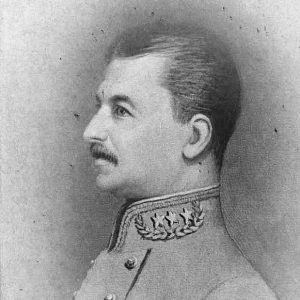calsfoundation@cals.org
Colton Greene (1832–1900)
Colton Greene was a Civil War Confederate colonel from Missouri who saw extensive action in Arkansas, often leading brigades, although he never received a general’s rank.
Born in South Carolina in 1832, Colton Greene was a partner in a wholesale grocery business in St. Louis, Missouri, and, by 1857, was an active member of the Democratic Party. As the clouds of disunion grew, he became a staunch secessionist. A confidante of Missouri governor Claiborne Jackson, Greene was sent to Richmond, Virginia, and to Arkansas to seek support for a Confederate invasion of Missouri in 1861.
Greene was on the staff of Seventh Military District chief Brigadier General James McBride at the August 10, 1861, Battle of Wilson’s Creek, Missouri, and was commissioned as a colonel by Jackson on October 28, 1861. When McBride resigned in early 1862, Greene took command of the Seventh District troops and reorganized them into two regiments, which he led during the Battle of Pea Ridge in Arkansas on March 7–8, 1862.
Greene and his small brigade transferred east of the Mississippi River with the rest of Major General Earl Van Dorn’s army after their defeat at Pea Ridge (Benton County), but a few months later he returned to the Trans-Mississippi. After raising the Third Missouri Cavalry Regiment (CS), he was named its colonel on November 4, 1862.
Greene headed a brigade in Brigadier General John Sappington Marmaduke’s April 27–May 2, 1863, raid into Missouri that culminated in the Skirmish at Chalk Bluff in Clay County. Later operating around the Federal base at Helena (Phillips County), Greene led troops in the May 11, 1863, Skirmishes at Taylor’s Creek and Mount Vernon on Crowley’s Ridge and at the July 4, 1863, Battle of Helena. After the Union capture of Little Rock (Pulaski County) on September 10, 1863, Greene led one of three Confederate columns that hit Colonel Powell Clayton’s small Union garrison at Pine Bluff (Jefferson County) in a failed attack on October 25, 1863.
During Major General Frederick Steele’s Camden Expedition in the spring of 1864, Greene and his men fought in the April 9–13 Skirmish at Prairie D’Ane and the April 18 Engagement at Poison Spring. When Steele abandoned Camden (Ouachita County) on April 26 following the disastrous loss at Marks’ Mills, Greene’s cavalry engaged the retreating Federals in the Skirmish at Saline Bottom three days later. Steele’s army ultimately escaped across the Saline River after the April 30 Engagement at Jenkins’ Ferry.
Greene led Marmaduke’s brigade into southeastern Arkansas in late May 1864 to disrupt Union shipping around the Greeneville Bends of the Mississippi River, of which he reported: “I engaged 21 boats of all descriptions, of which 5 gun-boats and marine-boats were disabled, 5 transports badly damaged, 1 sunk, 2 burned, and 2 captured. My loss was 1 subaltern and 5 privates slightly wounded….These operations have demonstrated the practicability of blockading or seriously interrupting the navigation of the Mississippi River with field artillery.” The Federals dispatched 6,000 troops under Brigadier General Andrew J. Smith to drive Greene away, but they would suffer significant casualties in the June 6 Engagement at Old River Lake. Greene also led troops in Major General Sterling Price’s disastrous raid into Missouri in late 1864.
Having lost his St. Louis business and property during the war, Greene moved to Memphis after the Confederate surrender and worked for the Knickerbocker Life Insurance Company before founding his own business in 1871 and later becoming the founding president of the State Savings Bank. As a civic leader, he wrote an 1886 report calling for a publicly owned and operated water system to combat the disease epidemics that had ravaged the city. He also organized the Mystic Society of Memphis and annual celebrations of Mardi Gras in the city.
Greene helped establish a public library in Memphis, and when he died on September 23, 1900, he left more than 500 books from his large collection to the library. Memphis’s Commercial Appeal eulogized him: “A rare character and a grand citizen he was and hundreds of people who have known and admired him will whisper a heartfelt requiescat.” Greene is buried in Memphis’s Elmwood Cemetery.
For additional information:
Allardice, Bruce S. More Generals in Gray. Baton Rouge: Louisiana State University Press, 1995.
“Gen. Colton Greene.” Memphis Commercial Appeal, October 1, 1900, p. 5.
Jones, John, and Doug McQuirter. “Colton Greene Collection, Revised.” Memphis Public Library. Collection description online at https://memphislibrary.contentdm.oclc.org/digital/collection/p13039coll1/id/97 (accessed June 14, 2023).
Smith, Myron J. “Interdicting the Mississippi: Colton Greene vs. The U.S. Navy.” North and South 12 (March 2011): 30–39.
Mark K. Christ
Central Arkansas Library System
 Civil War through Reconstruction, 1861 through 1874
Civil War through Reconstruction, 1861 through 1874 Military
Military Colton Greene
Colton Greene 



Comments
No comments on this entry yet.